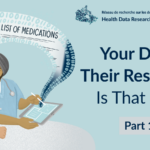Your health data, their research – Is that OK? Part 1


Using health data in research promises clear benefits: better patient care, better health system planning, and a deeper understanding of disease and well-being. But it also raises concerns – about privacy, commercial motives and equity. The term social licence refers to the ongoing acceptance and approval of an organization’s activities by its stakeholders and the wider community. In health research, it is essential to maintain social licence by understanding community concerns and the conditions that underpin public support for the use of health data in research.
Research teams from Health Data Research Network in Canada and Population Health Research Network in Australia separately explored community attitudes towards the use of health data in research. We compared the approaches taken and findings yielded by the two studies, revealing shared values and some interesting differences between Canadians and Australians.
How we listened to community members
In 2022, the Canadian research team recruited 20 experienced patient and public advisors (individuals with experience in advising hospitals, community organizations and governments on public views of health data) to investigate which health data uses they supported or opposed, in addition to what they considered to be essential requirements for social licence, like privacy and transparency. Inclusive design was used to highlight minority views and a “fist to five” method was used to build consensus. This approach allowed participants to express varying degrees of agreement or concern on each topic and ensured that minority voices were heard.
In contrast, the Australian researchers examined community members’ attitudes towards the use of health data by the private sector and the use of general practice data in research. A variety of activities were conducted between 2019 and 2023, including focus groups, nationally representative surveys and community juries. These combined methods gave a comprehensive and nuanced understanding of community attitudes across diverse populations.
What communities want: striking similarities between Canada and Australia
Despite the different research approaches used, the two studies showed that many conditions for social licence were shared by the two countries. Both Canadians and Australians had the following expectations:
- Benefits: Data sharing must serve the public good
- Equity and fairness: Vulnerable communities need to be consulted and protected
- Governance and oversight: Independent governance bodies are important
- Privacy and security: Identifying information should be removed from health data before it is used
- Transparency: Research results must be communicated in plain language
Where views diverged: consent and use of health data by the private sector
Consent models sparked contrasting opinions. Canadians preferred opt-in (explicit) consent, which requires that individuals actively agree to the collection or use of their data. Australians generally preferred an opt-out approach, which assumes that consent is given unless an individual actively withdraws it.
“No sharing of data without the consent of the person in question: this is essential so that data [use is] in the best interest of the people who shared their data” ~ Canadian participant
“I think opt-out is obviously the best one…you will get the best data. Some people will opt-out, but to have a complete non-consent would mean that people would be too wary to go to the doctors…” ~ Australian participant
Private sector involvement also divided opinion. Some Canadians expressed concerns of commercial exploitation of health data, whereas others acknowledged the private sector’s role in health care innovation. Australians tended to be more supportive of the private sector using health data for research and development, provided there were safeguards and penalties for misuse.
“Data are forever and health data are valuable. The private sector cannot be trusted to be in the public’s best interest, because they are beholden to create wealth for shareholders.” ~ Canadian participant
“I think the biggest impact is on reputation. A lot of big companies go, you know what, ‘We can handle a $100,000 fine… but the reputation is what will cost them in the long run. I think that’s the biggest disincentive you could have.” ~ Australian participant
What’s next?
Many factors impact community attitudes towards the use of health data in Canada and Australia. Our research was conducted between 2019 and 2023, a period shaped profoundly by the COVID-19 pandemic, which likely influenced public trust in data sharing and health systems overall. This is why continued research into health data social licence across populations, and putting in place effective and ongoing monitoring methods, is so important. The takeaway? For health data research to thrive and benefit everyone, it must be grounded in public trust, transparent governance and respect for diverse community views.
Written by Julia Burt (HDRN Canada), Catherine Street (HDRN Canada), Felicity Flack (PHRN Australia) and Kate Miller (PHRN Australia).
